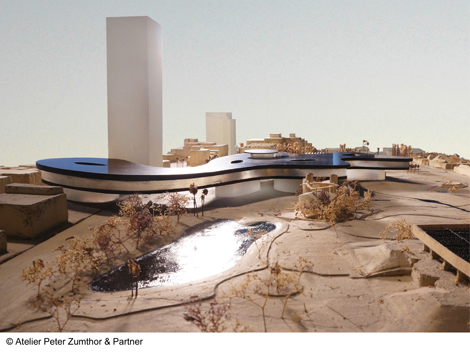LACMA is moving forward on the funding and eventual construction of the controversial $650-million-plus Peter Zumthor–designed building project that will replace three of the existing buildings and will bridge over Wilshire Boulevard.
Zumthor has done superb work on smaller projects, the Kolumba Museum in Cologne for example, by employing minimalism to achieve sublime background neutrality, where presentation of the art is dramatized against the low-key sheen and subtle textures of artisan concrete surfaces. The LACMA project, flattened into a pancake by Michael Govan’s requirement for a single-story museum, will be comparable in size to the nearby Grove—an immense shopping mall nearby. (The LACMA building will be about 450,000 square-feet. The Grove is approximately 600,000 square-feet.) A plan with Zumthor’s concrete rooms repeated across a single-story building of this size, regardless of their aesthetic beauty, will result in a tiring labyrinth of conventional galleries.
In hopes of redeeming the park space the building will consume, the entire slab will be lifted up at least 14 feet on glass drums, and the building’s elevated perimeter will be sealed behind glass. The casual access to the outdoors we now enjoy at LACMA will be eliminated. The only exit will by an elevator or escalator ride down into a gaping space underneath the building as vast as the building itself. The slick, intimidating concrete model has received only negative responses from architecture critics, and incidentally, has received the Darth Vader award from the Westside Urban Forum.
As reported by Joseph Giovannini in The Los Angeles Review of Books in July, LACMA, already servicing a $350 million bond debt for the Broad building and the Resnick Pavilion, could not pay the interest, and so leased the museum’s valuable May Company building. The arrangement for this prime real estate amounted to a steal: effectively a 110-year lease to the Academy of Motion Pictures at 10 cents per square foot—1/30th to 1/50th of its real value. It is impossible to grasp why the Academy—possibly the most well-funded tenant LACMA could hope to have—received give-away rates.
Now, with the Zumthor project, LACMA will more than double their debt to $650 million or more, with annual payments of at least $30 million—not counting operating and acquisition expenses. By crossing Wilshire they will occupy museum-owned real estate across the street, thus eliminating an important income source, many millions annually if developed properly. If LACMA can’t come up with private money to make the onerous bond payments on the Zumthor project, who will have to pay them?
The schematic single-story plan of this major new museum eliminates a broad range of expressive variations in volume, point of view, transmission of natural light, and the oblique or “z” axes that have become the salient strengths of contemporary museum design. Its sheer size squanders LACMA’s park space and real estate. The conceptual flaws in this project make it a financial risk not worth taking.
Worse, it should never have gone this far without critical review. Choice of architect and the heightened scope of the project were decided behind closed doors with no RFQ, no competition, and no open selection process. As a public museum, LACMA should explore collaborative interactions with the public it is there to serve, rather than dictate personal aesthetic preferences from its director and board.
For all intents and purposes, Michael Govan chose the architect and by requiring a one-story building, determined its outcome. LACMA’s idea of involving the public was to show us what they would be doing after they decided to do it. Choosing an architect and a building for a public museum, based on personal aesthetic preferences without allowing public input to shape those choices prior to making them is at best a serious error and at worst, a breach of public trust.


